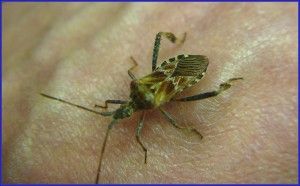
Western conifer seed bug
Western conifer seed bug (Leptoglossus occidentalis)
The western conifer seedbug was first described in the western United States. This true bug of the family Coreidae feeds mainly on the seeds and developing cones of several species of conifers and their respective hybrids. This bug has been expanding its range eastward and was first found in Michigan in the fall of 1987. Today, its range extends across the northern United States into Canada. The western conifer seed bug becomes a nuisance when it enters homes in search of overwintering sites.
Adults are 3/4 inch long and brownish on top. The upper (dorsal) side of the abdomen is yellow or light orange with five transverse black patches. This orange and black pattern on the abdominal dorsum is revealed during flight. The flight pattern and loud buzz produced by this strong flying conifer pest resemble those of a bumble bee. The young nymphs are orange, and they become reddish brown after a few molts. The eggs, which are laid in chains on conifer needles, measure about 2 mm each in length.
According to observations made in the western United States, the western conifer seed bug produces a single generation each season. Adults emerge from overwintering sites in late May or early June and feed on one-year cones and inflorescences. Eggs laid on host conifers hatch in 10 days, and first instars feed on the needles and tender tissue of cone scales. Later, nymphs use their piercing-sucking mouthparts to feed on developing seeds. Nymphs in all five stages of development and new adults can be observed feeding on the same group of cones by mid-August, at which time the nymphs begin to reach adulthood. Adults feed on ripening seeds until early fall and then seek overwintering sites under pine bark, in dead and dry Douglas firs, and in hawk and rodent nests. At the onset of cold weather, adult western conifer seed bugs may also enter buildings in search of protected overwintering sites.
Even though this insect does not bite or sting, it causes concern among occupants of homes, offices, and laboratories when it comes indoors. Complaints from residents increase as the insect becomes more active and conspicuous on days in the fall and spring when the temperature is above freezing. In several areas in the northeastern United States, this insect has created great alarm when large numbers of adults suddenly invade houses looking for overwintering sites.
Many people who offer advice on reducing these unwelcomed guests suggest sealing exterior cracks and holes with caulking to prevent their entry inside. This may work on older homes with clapboard siding but no amount of caulk is going to keep them out of a home with vinyl siding. Vinyl siding and soffits are not tightly nailed down; these are nailed loosely or as they say in the trade, “hung”. It is done this way to allow these vinyl panels to expand and contract with changing temperatures. Fall invading insects can find their way around the edges of these loose panels and into wall voids and attics. If homes were not heated these bugs would likely be content to go dormant and spend the winter in these cozy confines. Unfortunately our homes are heated and this warmth keeps these bugs active and as such they find their way into the living space probably around baseboards, window and door moldings, openings for electrical outlets and fixtures, openings for heating/cooling vents and other such pathways. There is very little that can be done once the bugs are inside the walls. In homes invaded by these bugs, it is very common and likely that one will continue to see them throughout the winter.
Even aggressive and costly insecticide applications may not be effective because it is nearly impossible to treat every hidden area that may be harboring insects. Sealing cracks around electrical outlet boxes, switches and light fixtures, and around window and baseboard molding on the inside walls will help keep the bugs trapped within the walls. In older homes with double-hung windows equipped with pulleys, insects commonly enter living areas through the pulley opening. Masking tape applied over the opening will keep insects from entering through this route. A vacuum cleaner is a pretty effective method of removing the sluggish, slow moving bugs from the house. Spraying the outside walls of homes, especially the south and west facing walls, with a long lasting insecticide registered for this use in September can help reduce the number of insects entering homes. These sprays should be applied when the first bugs are noticed congregating on outside walls. Before treating the whole house, spray a small test area to make sure the insecticide does not stain the siding or paint. Be sure to read and follow all directions on the pesticide label. Spraying the outsides of homes will, no doubt, involve spraying above one’s head. Be sure to wear protective clothing such as a wide-brimmed hat and raincoat. Eye goggles are a must.




 Print
Print Email
Email




